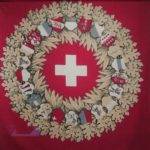Celtic tribes populated this region centuries before Christ. They were in close contact with the surrounding regions.
Trade extended to the Mediterranean region and beyond. The construction of roads and transport over mountain passes, rivers and lakes began after the arrival of the Romans.
The Middle Ages in the period 500-1000 were also years of major changes in Switzerland and certainly not ‘dark’. Switzerland as a country did not yet exist, neither did the name, nor the political concept.
The territory of Switzerland had a population of around 200,000 in the year 500, with an estimated 500,000 inhabitants in 1000.
The Catholic Church, abbeys, bishops and dioceses (Geneva, Lausanne, Sion, Chur, Basel (and Constance in Germany) played a prominent political (and military) role in the centuries following the departure of the Romans (fifth century).
The Merovingians, Carolingians, Burgundian kings and German kings were their secular opponents or supporters.
Mighty regional dynasties (Kyburg, Savoie, Habsburg, Zähringen and Swabia) and numerous local ruled over hundreds of territories. New cities were founded, a.o Bern and Fribourg.
The towns and rural communes in the so-called Urschweiz became autonomous in the course of the thirteenth and fourteenth centuries. The rise of imperial cities took place in the same period. They shaped the future of Switzerland.
The area of present-day Switzerland has always been an integral part of European cultural, political, religious, social and economic development and has been no exception.
The country developed a unique decentralised and democratic structure in a centuries-long process.
The French occupation in the years 1798-1813 set in motion reforms that could no longer be reversed.
They ultimately led to the Confederation of 26 cantons, four languages, direct democracy, prosperity, various religions and a relatively large capacity to accommodate and integrate newcomers.
The federal and decentralised organisation, the engagement of the citizens at local, cantonal and federal level, the (industrial) innovation, exports, excellent education (including excellent MSE-education) and above all the direct democracy are the hallmarks of the success of Switzerland. Switzerland is a grass-root country, incompatible with the top-down system of the European Union.
Switzerland is the true European Union of four languages, cultures and twenty-six republics and democracies in the middle of Europe.



